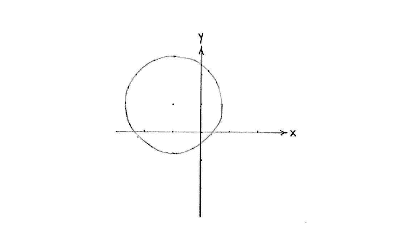Solution 4.1:7a
From Förberedande kurs i matematik 1
m (Lösning 4.1:7a moved to Solution 4.1:7a: Robot: moved page) |
|||
| Line 1: | Line 1: | ||
| - | {{ | + | As the equation stands, it is difficult directly to know anything about the circle, but if we complete the square and combine |
| - | < | + | <math>x</math> |
| - | {{ | + | - and |
| + | <math>y</math> | ||
| + | - terms together in their own respective square terms, then we will have the equation in the standard form, | ||
| + | |||
| + | |||
| + | <math>\left( x-a \right)^{2}+\left( y-b \right)^{2}=r^{2}</math> | ||
| + | |||
| + | |||
| + | and we will then be able to read off the circle's centre and radius. | ||
| + | |||
| + | If we take the | ||
| + | <math>x</math> | ||
| + | - and | ||
| + | <math>y</math> | ||
| + | - terms on the left-hand side and complete the square, we get | ||
| + | |||
| + | |||
| + | <math>x^{2}+2x=\left( x+1 \right)^{2}-1^{2}</math> | ||
| + | |||
| + | |||
| + | <math>y^{2}-2y=\left( y-1 \right)^{2}-1^{2}</math> | ||
| + | |||
| + | and then the whole equation can be written as | ||
| + | |||
| + | |||
| + | <math>\left( x+1 \right)^{2}-1^{2}+\left( y-1 \right)^{2}-1^{2}=1</math> | ||
| + | |||
| + | |||
| + | or, with the constants moved to the right-hand side, | ||
| + | |||
| + | |||
| + | <math>\left( x+1 \right)^{2}+\left( y-1 \right)^{2}=3</math> | ||
| + | |||
| + | |||
| + | This is a circle having its centre at | ||
| + | <math>\left( -1 \right.,\left. 1 \right)</math> | ||
| + | and radius | ||
| + | <math>\sqrt{3}</math>. | ||
| + | |||
{{NAVCONTENT_START}} | {{NAVCONTENT_START}} | ||
<center> [[Image:4_1_7a-2(2).gif]] </center> | <center> [[Image:4_1_7a-2(2).gif]] </center> | ||
{{NAVCONTENT_STOP}} | {{NAVCONTENT_STOP}} | ||
Revision as of 11:52, 27 September 2008
As the equation stands, it is difficult directly to know anything about the circle, but if we complete the square and combine \displaystyle x - and \displaystyle y - terms together in their own respective square terms, then we will have the equation in the standard form,
\displaystyle \left( x-a \right)^{2}+\left( y-b \right)^{2}=r^{2}
and we will then be able to read off the circle's centre and radius.
If we take the \displaystyle x - and \displaystyle y - terms on the left-hand side and complete the square, we get
\displaystyle x^{2}+2x=\left( x+1 \right)^{2}-1^{2}
\displaystyle y^{2}-2y=\left( y-1 \right)^{2}-1^{2}
and then the whole equation can be written as
\displaystyle \left( x+1 \right)^{2}-1^{2}+\left( y-1 \right)^{2}-1^{2}=1
or, with the constants moved to the right-hand side,
\displaystyle \left( x+1 \right)^{2}+\left( y-1 \right)^{2}=3
This is a circle having its centre at
\displaystyle \left( -1 \right.,\left. 1 \right)
and radius
\displaystyle \sqrt{3}.

